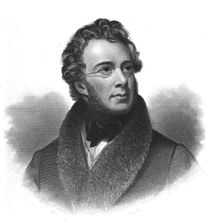Charles Fenno Hoffman

Charles Fenno Hoffman (February 7, 1806 – June 7, 1884) was an American author, poet and editor associated with the Knickerbocker group in New York.
Biography
He was born in New York City on February 7, 1806, the son of New York Attorney General Josiah Ogden Hoffman and Maria (Fenno) Hoffman (1781–1823, daughter of John Fenno). When 11 years old, his leg was crushed by a boating accident and had to be amputated. He attended New York University and Columbia College, and studied law with Harmanus Bleecker. He was admitted to the bar in 1827, but he practiced law only intermittently.
In 1833, he led a group of other students in the Eucleian Society in establishing the The Knickerbocker magazine, which he edited for the first three issues before passing duties on to Lewis Gaylord Clark.[1] In 1836, Park Benjamin, Sr. merged his New England Monthly Magazine with the American Monthly and hired Hoffman as editor, though he left to join the New York Mirror a year later.[2]
Hoffman's first book was A Winter in the Far West (1835), recounting his travels as far west as St. Louis, Missouri.[1] It was followed by Wild Scenes in Forest and Prairie (1837) based on actual experiences in search of health. He wrote a successful novel, Greyslaer (1840),[1] based on the murder of Colonel Solomon P. Sharp by Jereboam O. Beauchamp, known as the Beauchamp–Sharp Tragedy—an event that several writers, including Thomas Holley Chivers and William Gilmore Simms, also fictionalized.[3] Hoffman's version, however, had little in common with the true event.[4]
Hoffman's fame rested chiefly upon his poems, first collected in The Vigil of Faith (1842). Literary critic Rufus Wilmot Griswold that year dedicated twice as much space to Hoffman than any other author in his respected anthology The Poets and Poetry of America.[5] Griswold helped Hoffman publish The Echo, another collection of poetry, in 1844.[6] Hoffman was also popular for his songs. From a devoutly Lutheran family he nevertheless dealt with religious ideas in his writing from an inquisitive and open viewpoint. He became the editor of The New-York Book of Poetry, which first attributed A Visit From St. Nicholas to Clement Clarke Moore.
Hoffman remained a successful editor and author throughout the 1840s. He officially began a new role as editor of The Literary World magazine on May 1, 1847.[7] The weekly journal, which also included Evert Augustus Duyckinck and George Long Duyckinck, ceased publication in 1853.[8]
Insanity
Under the strain of work, he went insane in 1849,[5] supposedly after a servant used his manuscripts to start a fire. He was hospitalized briefly in April 1849 and, after his release, he accepted a position with the Department of State in Washington, D.C. By autumn, however, he was declared permanently insane.[9] He spent the last 35 years of his life in the Bloomingdale Insane Asylum, then a state asylum in Pennsylvania, and on land which later became part of Columbia University. It was at this state hospital in Harrisburg, Pennsylvania that Hoffman died on June 7, 1884.[10]
Selected list of works
- A Winter in the Far West (1835)
- Wild Scenes in Forest and Prairie (1837)
- Greyslaer (1840)
- The Vigil of Faith (poetry collection, 1842)
- The Echo (poetry collection, 1844)
References
- ↑ 1.0 1.1 1.2 Pattee, Fred Lewis. The First Century of American Literature: 1770–1870. New York: Cooper Square Publishers, 1966: 493
- ↑ Bayless, Joy. Rufus Wilmot Griswold: Poe's Literary Executor. Nashville: Vanderbilt University Press, 1943: 28
- ↑ Whited, Stephen R. (2002). "Kentucky Tragedy". In Joseph M. Flora and Lucinda Hardwick MacKethan. The Companion to Southern Literature: Themes, Genres, Places, People. Associate Editor: Todd W. Taylor. LSU Press. pp. 404–405. ISBN 0-8071-2692-6. Retrieved 2008-01-24.
- ↑ Barnes, Homer F. Charles Fenno Hoffman. New York: Columbia University Press, 1930: 124–125.
- ↑ 5.0 5.1 Pattee, Fred Lewis. The First Century of American Literature: 1770–1870. New York: Cooper Square Publishers, 1966: 494.
- ↑ Bayless, Joy. Rufus Wilmot Griswold: Poe's Literary Executor. Nashville: Vanderbilt University Press, 1943: 276.
- ↑ Miller, Perry. The Raven and the Whale: Poe, Melville, and the New York Literary Scene. Baltimore: The Johns Hopkins University Press, 1997 (first printed 1956): 203. ISBN 0-8018-5750-3
- ↑ Callow, James T. Kindred Spirits: Knickerbocker Writers and American Artists, 1807–1855. Chapel Hill: The University of North Carolina Press, 1967: 107.
- ↑ Bayless, Joy. Rufus Wilmot Griswold: Poe's Literary Executor. Nashville: Vanderbilt University Press, 1943: 149.
- ↑ Ehrlich, Eugene and Gorton Carruth. The Oxford Illustrated Literary Guide to the United States. New York: Oxford University Press, 1982: 198. ISBN 0-19-503186-5
- Cousin, John William (1910). "
 Hoffman, Charles Fenno". A Short Biographical Dictionary of English Literature. London: J. M. Dent & Sons. Wikisource
Hoffman, Charles Fenno". A Short Biographical Dictionary of English Literature. London: J. M. Dent & Sons. Wikisource
![]() This article incorporates text from a publication now in the public domain: Cousin, John William (1910). A Short Biographical Dictionary of English Literature. London: J. M. Dent & Sons. Wikisource
This article incorporates text from a publication now in the public domain: Cousin, John William (1910). A Short Biographical Dictionary of English Literature. London: J. M. Dent & Sons. Wikisource
External links
| Wikimedia Commons has media related to Charles Fenno Hoffman. |
| Wikiquote has a collection of quotations related to: Charles Fenno Hoffman |
| Wikisource has the text of a 1921 Collier's Encyclopedia article about Charles Fenno Hoffman. |
- Works by Charles Fenno Hoffman at Project Gutenberg
- Hoffman genealogy, at the William L. Clements Library of the University of Michigan
|